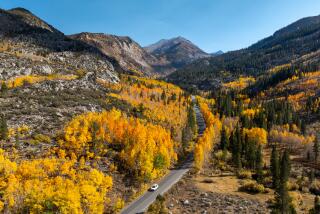Aspens Prove That Leaving Can Be Hard to Forget
- Share via
DURANGO, Colo. — For an all-too-short time in late September and early October the high mountain slopes and valleys of Colorado are ablaze with gold and copper and burnt orange. The aspen trees are performing their simple miracle of changing color.
It is an exultant time for the eyes, a festival for the camera lens. You can walk among the aspens and watch the sunlight suffuse the leaves with a golden aura. The leaves tremble and quiver with dancing light as the wind catches them, thus reaffirming their name: quaking aspen.
Considered one of the nation’s most beautiful trees, the aspen can go almost unnoticed in the East among the other hardwood species, but not in the West. It’s hardy, fast-growing and extremely popular.
“The aspen is almost a religious symbol to many people,” said Hank Deutsch of the U.S. Forest Service. “It’s symbolic of the Rocky Mountains. A clump of aspen is a desired thing to have in your yard.”
Stolen Trees
The appeal of aspen has led some to illegal extremes. Each year thieves steal about a million aspen trees from Colorado’s 11 national forests.
Concentrating their efforts on easy-to-transport seedlings and young trees 3 to 15 feet tall, the thieves use sophisticated methods of aerial surveys, radio scanners and refrigerator trucks.
Although the Forest Service issues thousands of transport permits for aspen, spruce and other conifers in Colorado and Wyoming, thieves sometimes use these permits to camouflage their illegal sales. It can be a lucrative business because aspens are continuously in demand.
Their appeal becomes obvious on a typical fall day in the high country, with the harmonious blend of cool air and warm sun.
As you drive your car upward on a curving mountain road, you can look down the draws and valleys to see the scattered groves of gold contrasted against the vast tracts of dark green pine and spruce.
In some places, slopes are splashed with vibrant yellow and amber. In others, entire mountainsides are painted with molten copper.
“To enjoy an aspen stand, you have to get into one,” Deutsch said. “Get out of your car, walk in under the trees, lie back, look at the sky and relax and enjoy it. For some odd reason, when you see the sunlight come through the trees, the air literally takes on a gold tinge. It’s a unique experience--fall in the Rockies.”
See the Magic
Standing in an aspen grove, you can see the magic. The Ute Indians once called the aspen leaves “women’s tongues” because they never stop moving.
Botanists, less prone to male chauvinism, explain the quaking leaves more scientifically. The leaves are almost circular, with a slight point. The slender stalk connecting the leaf to the stem is attached at right angles to the plane of the leaf so that the leaves shiver with the least breath of air.
In the sunlight, particularly backlighting, the slightest breeze seems to activate some inner mechanism of motion and the leaves dance and scintillate almost hypnotically.
At higher altitudes on steep slopes the aspen are sometimes twisted into peculiar shapes and, in the subdued light of twilight with their quivering leaves, they seem to be gliding into the shadows like wild animals.
More often they grow in thick groves close together. Their tall, straight trunks form symmetrical patterns of light and shadow in the early morning and late-afternoon sunlight.
But the spectacle is momentary. One day the leaves create an atmosphere of aspen glow; on the next, they are gone with the wind. In the words of novelist John Nichols, one sees their “preposterous soul-stirring arrogance of aspen-yellow flaming brightly and then subsiding.”
Late in the season the leaves begin to fall, like discs of captured sunlight, fluttering to the earth. For a time they are still bright coins of autumn.
Then the golden glow goes out until the ritual begins again the next year.
-- -- --
With almost 2 million acres of aspen in Colorado, many sites are ideal for viewing the changing leaves. Almost any road into the high country will take you near stands of aspen, but there are a select number of areas where the variables of altitude, soil, temperature, exposure and setting combine to produce breathtaking views.
It is no exaggeration. On certain days, without clouds, the interplay of light and shadow and color is spectacular.
The Forest Service recommends the following five routes:
--From Denver, take Interstate 70 west to Idaho Springs (or turn off on Colorado 119 to Central City or Colorado 103 to Mt. Evans). Continue on I-70 to Georgetown, then Dillon, and south on Colorado 9 to Breckenridge and Fairplay. At Fairplay, take U.S. 285 northeast through Bailey and back into the Denver area (184 miles).
--Drive I-70 west from Denver to Wolcott (just east of Eagle), then Colorado 131 north to Steamboat Springs. From Steamboat Springs take U.S. 40 west to Craig, then Colorado 13 south to Meeker and on south to Rifle. Get back on I-70 eastbound to Glenwood Springs, Eagle and Denver (273 miles).
--From Boulder, take U.S. 36 north through Lyons to Estes Park. Continue on Trail Ridge Road (U.S. 34) west through Rocky Mountain National Park to Granby. Then U.S. 40 south to I-70, east to Idaho Springs and Denver (216 miles).
--From Colorado Springs, take U.S. 24 west through Manitou Springs, Woodland Park, Florissant, Hartsel and Buena Vista, then U.S. 285 south to Poncha Springs. Continue east on U.S. 50 through Salida, Canon City and the Royal Gorge to Pueblo, then Interstate 25 north to return to Colorado Springs (254 miles). Another choice is to take Colorado 115 from Canon City back to Colorado Springs.
--From Dillon on I-70, drive west to Wolcott, Eagle and Glenwood Springs, then Colorado 82 south to Aspen. Continue on Colorado 82 over Independence Pass into Granite, which is on U.S. 24. Then go north on U.S. 24 to Leadville, north on Colorado 91 past Climax to I-70, northeast back to Dillon (206 miles).
More to Read
Sign up for The Wild
We’ll help you find the best places to hike, bike and run, as well as the perfect silent spots for meditation and yoga.
You may occasionally receive promotional content from the Los Angeles Times.






